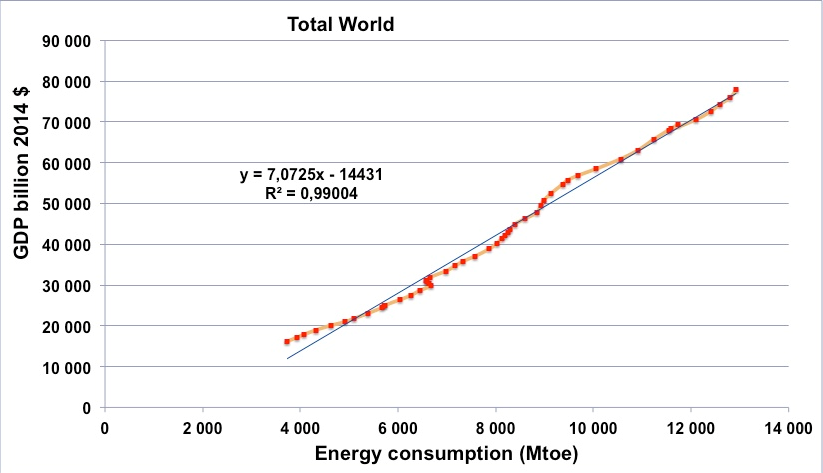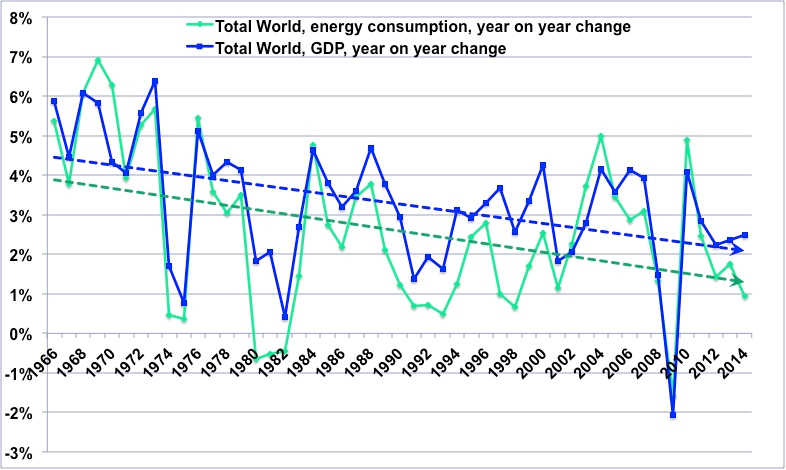But despite their differences, what these theories all have in common is that they tend to look at factors 'internal' to the economic system – such as innovation levels, the rate of savings, rising inequality, or the lack of Keynesian fiscal stimulus – to explain low-growth. An emerging school of 'biophysical' economists, however, argue that these type of explanations, while no doubt valid to some extent, overlook the importance of factors 'outside' the formal economic system in the determination of growth. These economists argue that the theoretical models of conventional economics, by only factoring in capital and labour, overlook, or at least vastly underestimate, the contribution of resources – and particularly energy resources – in making economic growth possible. But given the reality of resource depletion, and particularly of fossil fuels, it is precisely this understanding of the economic system as a subset of a wider energy (and ecological) system that, biophysical economists argue, is key to understanding the current stagnation.
Bio-physical economists make two (related) claims about the connection between the depletion of energy resources and economic stagnation. The first regards the declining rate of growth in energy (and particularly oil) supply, and the second regards the declining rate of net energy delivered to society.
Regarding the rate of energy supply growth, French theorist Jean Jancovici alerts us to the tight historical correlation between economic growth and increased energy consumption. This can be seen clearly in the following graph.
Advertisement

Source: Jancovici's calculation based on primary information coming from BP statistical review (energy) and World Bank (GDP).
From this premise Jancovici contends that secular stagnation can chiefly be attributed to the declining rate of growth in per capita energy consumption which, he shows, is closely correlated to the declining income growth as noted above.

Source: Jancovici's calculation on primary data coming from BP statistical review & various sources before 1965 (energy) and World Bank (GDP).
At a global level, since the twin oil shocks of the 1970s, the growth in per capita energy supply has slowed, from an average growth rate of 2.5% per annum between 1860 to 1980, to just 0.4% per annum since 1980. And if one looks just at the OECD, per capita energy supply has entirely stagnated since the 1980s, with many countries now experiencing a gross decline. It's true that the increasing efficiency of energy use means we can get more GDP growth from every unit of energy, but efficiency gains have not made growth any less dependent on rising energy consumption and thus the declining rate of per capita energy growth, Jaconvinci contends, is a critical factor in explaining secular stagnation.
Advertisement
A key question here, however, is whether correlation implies causation? That is, does the tight relationship between the declining per capita energy growth rate and GDP, mean that the former always causes the latter? Jaconvici argues that it does because historically the drop in per capita energy supply growth usually preceded the drop in per capita GDP. But his charts, such as the one above, do not always show this clearly. It could be that GDP growth is slowing for other reasons and – given the strong dependence of growth on rising energy – this is merely reflected in the declining rate of energy supply. Thus, while Jaconvici thesis may be correct, its far from proven to be so. It seems likely that declining gross energy supply is just one factor among several that have historically caused the slow-down in growth.
Most biophysical economists place more stress on the significance of a second manifestation of energy depletion, which is likely to be impacting the economy, particularly since the roughly the turn of the century – that is, the declining rate of energy return on energy invested (EROI). This is different from gross energy supply, because it looks instead at what proportion of gross energy is being delivered to society, once allowance has been made for the energy need for the supply task. The problem, biophysical economist point out, is that with the peaking of conventional oil in 2005, the global economy has become increasingly dependent on unconventional source of oil and gas, which are far costlier, in both energy and financial terms, to extract.

Discuss in our Forums
See what other readers are saying about this article!
Click here to read & post comments.
18 posts so far.